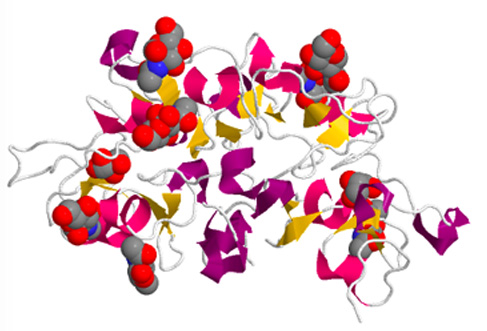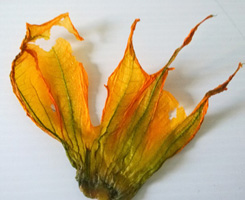Role of Lectins in Inflammation
About Lectins
Lectins are proteins found in all animals and are specific to bind carbohydrate structures. Lectins may be defined as molecules of non-immune origin that bind to specific carbohydrate receptors with high affinity (in the same range as the affinities of antibodies, and sometimes higher) (1).
Lectins role in plants may well be a of protection. Animals that eat their seeds produce inflammatory responses.
In animals, the main function of lectins is to facilitate cell-cell contact. A lectin usually contains two or more binding sites for carbohydrate units although some lectins form oligomeric structures with multiple binding sites. See image below.

SOURCE: 2UVO HIGH RESOLUTION CRYSTAL STRUCTURE OF WHEAT GERM AGGLUTININ IN COMPLEX WITH N-ACETYL-D-GLUCOSAMINE- (N-acetyl-d-glucosamine shown in CPK model, image created using Jsmol) (2)
The exact role of lectins in plants is unclear, although they can serve as potent insecticides. Castor beans contain so much lectin that they are toxic to most organisms.
Because of their ability to bind to virtually all cell types and cause damage to several organs, lectins are widely recognized as anti-nutrients within food. Most lectins are resistant to heat and the effects of digestive enzymes, and are able to bind to several tissues and organs. The administration of the lectin to experimental animals causes hyperplastic and hypertrophic growth of the small intestine, hypertrophic growth of the pancreas and thymus atrophy. Lectin activity has been demonstrated in wheat, rye, barley, oats, corn and rice. (see reference 6)
Binding sites and interaction of lectins with cells
The binding sites of lectins on the surface of one cell interact with arrays of carbohydrates displayed on the surface of another cell. Lectins and carbohydrates are linked by a number of relatively weak interactions that ensure specificity yet permit unlinking as needed. Selectivity is achieved through a combination of hydrogen bonding to the sugar hydroxyl groups with van der Waals packing, often including packing of a hydrophobic sugar face against aromatic amino acid side chains.
A classic lectin-carbohydrate binding is that seen between wheat germ agglutinin (WGA) with n-acetyl-d-glucosamine. See image above. Other know interactions are: alpha-mannose and alpha glucose for lentil letin, pea letin and conA; d-galactose for the peanut lectin and n-acetyl-d-glucosamine for lectins in soybeans.
Role of lectins in IBS
(Inflammatory Bowel Syndrome)- In people who suffers from Crohn’s disease or irritable bowel syndrome, the gut lining seems to be more sensitive to food lectins.
Inflammation is the response of the innate immune system triggered by noxious stimuli, microbial pathogens and injury. When a trigger remains, or when immune cells are continuously activated, an inflammatory response may become self-sustainable and chronic.
Intestinal barrier and inflammation
The intestinal barrier allows the uptake of nutrients and protects from damage of harmful substances from the gut lumen.
Chronic inflammation and autoimmune diseases occur by increasing intestinal permeability and initiating a pro-inflammatory immune response.
Increased intestinal permeability allows for the passage of microbial and dietary antigens across the epithelial layer into the lamina propria, where these antigens can be taken up by APC and presented to T-cells. JC, junctional complex.
Changes in intestinal tight junction permeability associated with industrial food additives explain the rising incidence of autoimmune disease --Glucose, salt, emulsifiers, organic solvents, gluten, microbial transglutaminase, and nanoparticles are extensively and increasingly used by the food industry, claim the manufacturers, to improve the qualities of food. However, all of the aforementioned additives increase intestinal permeability by breaching the integrity of tight junction paracellular transfer. In fact, tight junction dysfunction is common in multiple autoimmune diseases and the central part played by the tight junction in autoimmune diseases pathogenesis is extensively described. It is hypothesized that commonly used industrial food additives abrogate human epithelial barrier function, thus, increasing intestinal permeability through the opened tight junction, resulting in entry of foreign immunogenic antigens and activation of the autoimmune cascade. Future research on food additives exposure-intestinal permeability–autoimmunity interplay will enhance our knowledge of the common mechanisms associated with autoimmune progression.
Do dietary lectins cause disease?
"...Lectins are carbohydrate binding proteins present in most plants, especially seeds and tubers like cereals, potatoes, and beans. Until recently their main use was as histology and blood transfusion reagents, but in the past two decades we have realized that many lectins are (a) toxic, inflammatory, or both; (b) resistant to cooking and digestive enzymes; and (c) present in much of our food.2 It is thus no surprise that they sometimes cause “food poisoning.” But the really disturbing finding came with the discovery in 1989 that some food lectins get past the gut wall and deposit themselves in distant organs.3,4 So do they cause real life diseases?.." (3)
Lectins and Autoimmune disease
Lectins stimulate class II HLA antigens on cells that do not normally display them, such as pancreatic islet and thyroid cells.
Another suspect lectin disease is rheumatoid arthritis. The normal human IgG molecule possesses carbohydrate side chains, which terminate with galactose. In rheumatoid arthritis much of the galactose is missing, so that the subterminal sugar—N-acetyl glucosamine—is exposed instead. These deficient IgG molecules feature strongly in the circulating immune complexes that cause fever and symptoms. In diet responsive rheumatoid arthritis one of the commonest trigger foods is wheat, and wheat lectin is specific for N-acetyl glucosamine—the sugar that is normally hidden but exposed in rheumatoid arthritis. This suggests that N-acetyl glucosamine oligomers such as chitotetraose (derived from the chitin that forms crustacean shells) might be an effective treatment for diet associated rheumatoid arthritis. Interestingly, the health food trade has already siezed on N-acetyl glucosamine as an antiarthritic supplement.(3)
Blocking lectins
Because of their precise carbohydrate specificities, lectins can be blocked by simple sugars and oligosaccharides. Wheat lectin, for example, is blocked by the sugar N-acetyl glucosamine and its polymers.5 These natural compounds are potentially exploitable as drugs should lectin induced diseases be identified.
N-Acetyl- Glucosamine (NAG) and Glutamine
NAG is involved in the repair of mucous membranes throughout the body and help repair the extracellular tissue and barrier of the gastrointestinal system. It will also decrease the binding of some lectins which cause the damage.
L-glutamine is consumed by intestinal cells more than any other cells and is a major source of energy for proliferation and repair of intestinal epithelial cells. Note: People with cancer should avoid l-glutamine since cancer cells will use it for energy and be able to replicate faster.
Role of Zonulin in Inflammation and leaky gut
Together with the gut-associated lymphoid tissue and the neuroendocrine network, the intestinal epithelial barrier, with its intercellular tight junctions, controls the equilibrium between tolerance and immunity to non-self antigens. Zonulin isi a 47-kDa inflammatory protein that was discovered in 2000 by Alessio Fasano and his team at the University of Maryland School of Medicine. The protein helps regulate leakiness in the gut by opening and closing the spaces or "junctions" between cells in the lining of the digestive tract. Zonulin has been shown to be upregulated in several autoimmune diseases, including celiac disease (CD) and type 1 diabetes (T1D), in which TJ dysfunction seems to be the primary defect (see References herin)
It appears that gluten may be a strong trigger of zonulin in some individuals. And since no human can completely digest gluten, this may present a problem for some individuals who present a zonulin response to gluten. (See References 5,6) In additon Zonulin, is found in higher levels in the blood of both celiac and non-celiac gluten-sensitive individuals,
Readings and References
1-Lectins
2- High resolution crystal structure of wheat germ agglutinin
3- Do dietary lectins cause disease?
4-Structural basis of lectin-carbohydrate recognition.
5-Lectins and Inflammation-Why You Want To Avoid Them If You Are Autoimmune
6-The Dietary Intake of Wheat and other Cereal Grains and Their Role in Inflammation
Gluten and Gluten Sensitivity
What is Gluten and how to identify it? What is the molecular structure of gluten?
Gluten is a protein found in wheat. What part of the wheat grain is it located? How can you identify foods that contain gluten? ... read more.
What are the genes in the Human Genome responsible for Celiac Disease?There are two genes that are responsible for Celiac disease although other genes and environmental factors play a role in those that get the disease, since as many as 30-40% of the population may have the gene(s) but not show symptoms... read more.
Why is an immune response triggered against gluten in some individuals?How does gluten cause celiac disease?... read more
What is the difference between celiac disease and gluten sensitivity?Only 1% percent of the population has true Celiac disease. Many more have what is know as gluten sensitivity What is the difference between the two, and how to know which one you have... read more. Is gluten the only substance in wheat people are sensitive to? ... read more.
What are the ongoing Clinical Trials for Celiac DiseaseThere is still a lot that is not understood about how gluten's affect humans... many clinical trials are underway... read more
What are lectins -why are they toxic and cause illness?Both plants and animals contain lectins. What are they and why can they be very toxic to our bodies. Why do beans have to be soaked and properly cooked? What is the role of lectins in autoimmune disease? ...read more
Role of Lectins in InflammationAlthough gluten has been in the limelight for sometime, many people may not realize that other lectins may be causing digestive issues... read more
How to Enhance Flavor in Cooking

Flavor can be enhanced many ways... Umami is now the commonly used term by taste scientists for the fifth taste but brining, curing and dehydrating are also very effective methods.
- Adding flavor using Umami
- Brining and Curing
- How to Roast Tomatoes for Umami Flavor ...
- How to freeze zucchini blossoms
- Science of zucchini blossoms
- Dehydrating Foods -- Zucchini blossoms
- Science of Saffron
- Science and Health Benefits of Ginger
- Why dried shitake mushrooms have more flavor than fresh